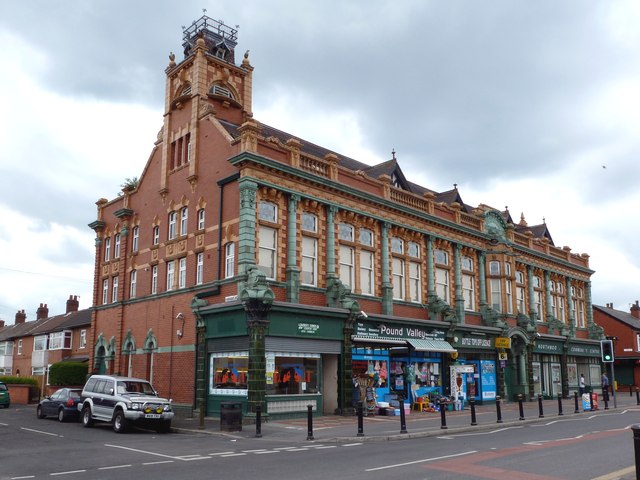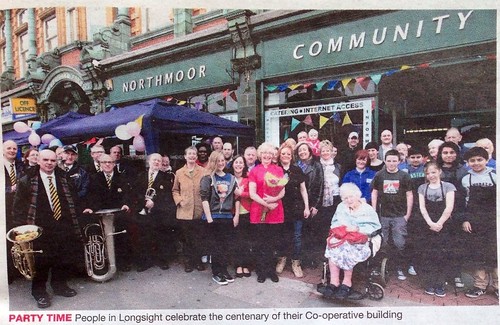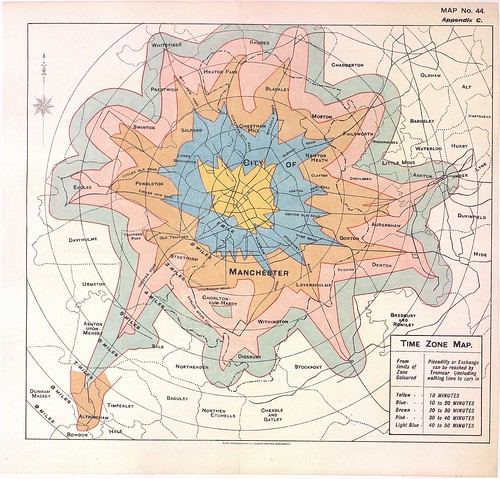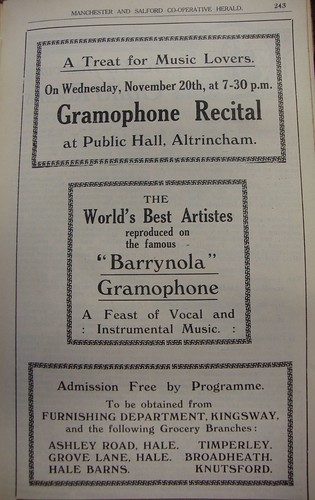Hardy Lane Scrapbook
Situated in a suburb of Manchester, England this is a story of a co-op store still with meeting rooms above the shop, and the lane itself. Plus other related or not so related history.
Sunday, October 27, 2013
Co-Op First Self Service UK
If you browse for finding the first self service store in Britain then you'd have to dig very deep to find any mention of a co-operative bringing the concept from the USA to the UK. There was a recent three part documentary on shopping and retailing by the BBC and any part that the CWS or any co-operative society played in any retail innovation was seriously omitted.
The first own label goods are by the CWS date from 1873 and the use of own manufactured goods to beat the restrictions of Retail Price Maintenance are from 1906 with some patent medicines, and better known the Defiant Radios in 1933.
Now to the first self service grocery, it wasn't J.Sainsbury or Tesco but the London Co-Op Society who opened a small section in a Romford department store in 1942. Apparently introduced to alleviate staff shortages during the war. The first stand alone self service shop in Britain goes to Portsea Island Co-Op in March 1948. It's one of those great trivia facts that the city of Portsmouth is actually on an island linked by bridges to the English peninsular. Portsea island being the third most populated island the British Isles.
The London Co-Op Society sent a delegation to the USA and Canada as early as 1938 to study the self service format. The CWS sent a research team to the USA in 1947, and published guidance on how to run a self service outlet in 1949. The M&SE (Manchester & Salford Equitable) took to idea and started altering its existing stores the following year. Eventually the format came to the smaller stores like Hardy Lane in 1959.
[ Information from the letter pages of the Co-Operative News in October 2013 ]
Thursday, October 3, 2013
CWS 150 renamed and not out
Not many companies can make 150 years of trading but the Co-Operative Group was founded as the North of England Co-operative Wholesale Industrial and Provident Society Limited in Manchester in 1863. From 1872 it became the Co-Operative Wholesale Society (CWS), and after a merger with Co-Operative Retail Services in 2000 they chose the name Co-Operative Group.
Forward to the present day and an exhibition at the People's History Museum in Manchester on Saturday 12th October 2013 thru to Saturday 11th May 2014. Plenty of visiting days, it's free and there is a fine cafe too. More to follow....after the exhibition opens. Might as well join in by publishing some photos of CWS memorabilia like the 1940's packet of tea as seen above. That's a 4oz packet of loose tea before tea bags became the norm...more pictures to follow.
All the links you need:
The People’s Business – 150 Years of The Co-operative
Co-Op Events at the People's History Museum
Co-Operative Group at 150 years (pictures and timeline)
Forward to the present day and an exhibition at the People's History Museum in Manchester on Saturday 12th October 2013 thru to Saturday 11th May 2014. Plenty of visiting days, it's free and there is a fine cafe too. More to follow....after the exhibition opens. Might as well join in by publishing some photos of CWS memorabilia like the 1940's packet of tea as seen above. That's a 4oz packet of loose tea before tea bags became the norm...more pictures to follow.
All the links you need:
The People’s Business – 150 Years of The Co-operative
Co-Op Events at the People's History Museum
Co-Operative Group at 150 years (pictures and timeline)
Tuesday, September 17, 2013
Touching History Roby Church
I've written many times about how the Manchester & Salford Equitable Co-op was founded by members of the Roby Brotherhood. A 19th Century group of young men who worshipped at the Roby Church and had attended that Sunday School. Walking down Dickenson Road you can see one of their former church buildings. It's at the corner of Hamilton Road and is now used by the Church of God of Prophesy. Better still sautering further south down Dickenson Road is the actual successor church, the Roby United Reform Church. A neat stylish building in smart brick with a small attractive garden. There you can touch the names carved in stone of the early preachers.

William Roby was invited to preach at the Cannon Street chapel in 1830, and they moved to larger premises on Grosvenor Street in 1807. The chapel was renamed Roby in his memory after his death. I doubt if many of the founders of the Manchester & Salford Co-op would have heard him speak. But they would have been familiar with Richard Fletcher who went off to pastures new in Melbourne, Victoria, and Patrick Thomson who had a long career at various independent churches.
As a side note to illustrate how history is an ivy that intertwines. William Roby (1766-1830) ran an academy to teach independent preachers, and from 1803-1808 it was funded by Robert Spear (1792-1819) a wealthy cotton merchant in Manchester. "Robert Owen describes how Spear sent him the first two bags of Sea Island cotton to land in Britain. It was through Spear's sister that Owen met his future wife Caroline Dale." - paraphrased from the Life of Robert Owen (1920). The New Lanark mills were part of the marriage settlement. Yet another co-op connection.
Further Reading :
William Roby brief biog
History of the Roby Church

William Roby was invited to preach at the Cannon Street chapel in 1830, and they moved to larger premises on Grosvenor Street in 1807. The chapel was renamed Roby in his memory after his death. I doubt if many of the founders of the Manchester & Salford Co-op would have heard him speak. But they would have been familiar with Richard Fletcher who went off to pastures new in Melbourne, Victoria, and Patrick Thomson who had a long career at various independent churches.
As a side note to illustrate how history is an ivy that intertwines. William Roby (1766-1830) ran an academy to teach independent preachers, and from 1803-1808 it was funded by Robert Spear (1792-1819) a wealthy cotton merchant in Manchester. "Robert Owen describes how Spear sent him the first two bags of Sea Island cotton to land in Britain. It was through Spear's sister that Owen met his future wife Caroline Dale." - paraphrased from the Life of Robert Owen (1920). The New Lanark mills were part of the marriage settlement. Yet another co-op connection.
Further Reading :
William Roby brief biog
History of the Roby Church
Sunday, September 15, 2013
Longsight Printing Works
Reading through many old co-op society magazines and pamphlets the imprint "CWS Printing Works Longsight" is on the publication. I thought the old printing works had long since been demolished until I took a cycle short cut down Hamiliton Road in Longsight and caught glimpse of the building. It took a few more months before returning with a camera.
CWS Printing commenced in January 1895 off Balloon Street in Manchester, and such was the need for more output a site was acquired in Longsight and production commenced in July 1898. The works expanded over the years and employed 1,100 persons in 1913. Printing wasn't as mechanised as today so lots of hands, both men and women were needed to collate, trim, bind and box all that paper.

The attractive engraving shows a magnificent structure and with artistic licence the roads are shewn overly wide and spacious. Built on large open plot behind the shops on Stockport Road with Gore Brook and Rushford Farm to the right and east of this illustration. It has been knocked about since its heyday. The chimney and pond have gone, the brook is under a culvert but the original entrance to the offices on Hamilton Road survives.

 The illustration is from The Story of the CWS: the jubilee history of the Co-Operative Wholesale Society by Percy Redfern (1913). You can download it at Archive.Org
The illustration is from The Story of the CWS: the jubilee history of the Co-Operative Wholesale Society by Percy Redfern (1913). You can download it at Archive.Org
CWS Printing commenced in January 1895 off Balloon Street in Manchester, and such was the need for more output a site was acquired in Longsight and production commenced in July 1898. The works expanded over the years and employed 1,100 persons in 1913. Printing wasn't as mechanised as today so lots of hands, both men and women were needed to collate, trim, bind and box all that paper.

The attractive engraving shows a magnificent structure and with artistic licence the roads are shewn overly wide and spacious. Built on large open plot behind the shops on Stockport Road with Gore Brook and Rushford Farm to the right and east of this illustration. It has been knocked about since its heyday. The chimney and pond have gone, the brook is under a culvert but the original entrance to the offices on Hamilton Road survives.

 The illustration is from The Story of the CWS: the jubilee history of the Co-Operative Wholesale Society by Percy Redfern (1913). You can download it at Archive.Org
The illustration is from The Story of the CWS: the jubilee history of the Co-Operative Wholesale Society by Percy Redfern (1913). You can download it at Archive.Org
Monday, April 29, 2013
Northmoor Road

The old co-op building on Northmoor Road in Longsight, Manchester M12 5RT is an impressive building. Enough to be classed as a Grade II Listed Building in 1994. The other week it celebrated its centenary, only a few months late as the date on the building states 1912.
It was built for the Beswick Co-operative Society, founded in 1892, and a thorn in the trading area of the Manchester & Salford Equitable. The Beswick ignored any territorial agreements and would open branches were they felt they could do business. Thus districts like Levenshulme, Ancoats, Withington and Didsbury would have rival co-op stores.
Northmoor Road, originally called North Road was developed between 1899 thru to the 1930's. The most famous person to reside there was J.R.Tolkien between 1926-1947. We don't know if he went to the co-op for his tea and biscuits between writing another page of The Hobbit or Lord of The Rings.

The building rises up to two floors plus attic rooms in a square tower. It used to have a meeting room used as ballroom for dances to live music. The property is now owned by Great Places Housing Group who provide affordable, social and supported housing across the north west and Yorkshire. There is now a community centre and small business units on the ground flour. Apartments are on the upper levels. It's not every building that has a party by local residents to celebrate its 100th birthday. It was reported in the local newspaper, "the co-operative building is loved by all in the area, and that showed with the amount of local residents who came to the event." - South Manchester Reporter 25th April 2013.
There is no doubt a lot of history to this building, it is something I must follow up someday.
Further reading : Northmoor Road (Wikipedia)
Description of the architectural features (Images of England)
Photo credit to www.geograph.org.uk
Sunday, April 7, 2013
Trams beyond Chorlton

The tram tracks are now being laid down the centre of Hardy Lane. Slowly the construction of the line to connect the airport with the centre of Manchester is coming along. I'm recording the progress with photographs.
As Hardy Lane is not a busy thoroughfare for cars reducing the road to single line traffic shouldn't cause any long tail backs. However the siting of the station at the junction of Mauldeth Road West and Barlow Moor Road might isn't ideal. Not ideal for foot passengers who will have to cross two main roads to reach the platforms. You have a similar situation in Droylsden and there are no cycle lanes to contend with there.
The picture below is from the Manchester Libraries Archives. It shews the tram times to reach the centre of town from the outlying districts in 1917.

Depending on which part of Chorlton-cum-Hardy you lived in it could take from between 20 minutes to 50 minutes to arrive at Piccadilly. It is maybe marginally faster on the Metrolink these days but then you have to factor in the time to walk to the station.
Friday, March 29, 2013
Twin tubs carry on

I'll draw your attention to a famous brand of washing powder and the words printed on the packet. The reference is to "twin tubs". Had I stepped into the past and not another shopping trip to the local Co-Op. Well apparently twin tub washing machines are still manufactured and presumably someone is buying them and Proctor & Gamble are marketing a washing powder to cater for that market. It is not widely promoted in the Daz range, it hardly gets a mention. What's the difference? This soap powder will make more suds so is unsuitable for an automatic washing machine.
Washing clothes that weekly chore that requires lots of hot water isn't the full drudge day of years ago. Well not when you have an automatic washing machine. So there must be some reasons why people still favour the machine of choice from the 1960's. Maybe it does a cleaner wash, or is eco-friendly besides being a cheaper capital purchase. The powder is also for handwash (not hand wash) and you can't go further back in history than laundry by hands.
Wednesday, March 27, 2013
Gramophone Music

The history of recorded music is how it has progressively become cheaper and more convenient. You don't even have to possess the physical object that holds the sound just some electronic device that can play it. Literally bushels of songs at the fingertip. The advert is from the 1930's and the M&SE are stocking the new Barrynola gramophone. Note it is being demonstrated at a concert in one of the more salubrious suburbs of Manchester. A night out listening to records - no mention if dancing was allowed.
Interesting class dimension in that the Co-Op was appealing to not just the weekly struggle working class customer but to customers who had regular income with savings.
They were an expensive purchase not one for a struggling working family. A small portable would cost just under £3 (3 GBP), a cabinet model from £7 to £10. Then there were the new electric models using mains electricity. The new radiograms were also coming on the market, a status piece of furniture that would be desired for living rooms for the next twenty years. This was an age of developments in reproducing sound. Just as today there is that newer and better model available after you've paid your hard earned cash and taken delivery. Last year I purchased an iPod Nano that also doubles as a wrist watch. That model has been superseded, and my Zen MP3 player is ancient. We've not even gone into the junk room to find museum pieces like the Walkman.
The co-op society did hire gramophones and the Womens' and Mixed Guilds made use of such facilities to have a meeting based around listening to recorded music. I had an earlier post, it was back in 2009, about 78 rpm records that were played at Hardy Lane. It is here.
So there you have it. I'm sat on the tram listening to my own personal playlist on little ear speakers and all those years ago it was a treat of an evening in a hall hearing gramophone records.
Subscribe to:
Posts (Atom)
You can email : coop AT biffadigital.org with any information that will help in the making of this history.


